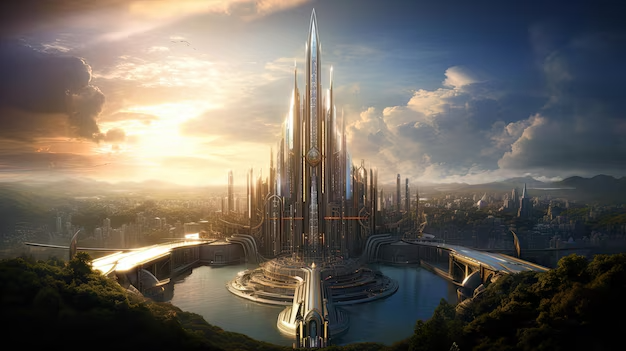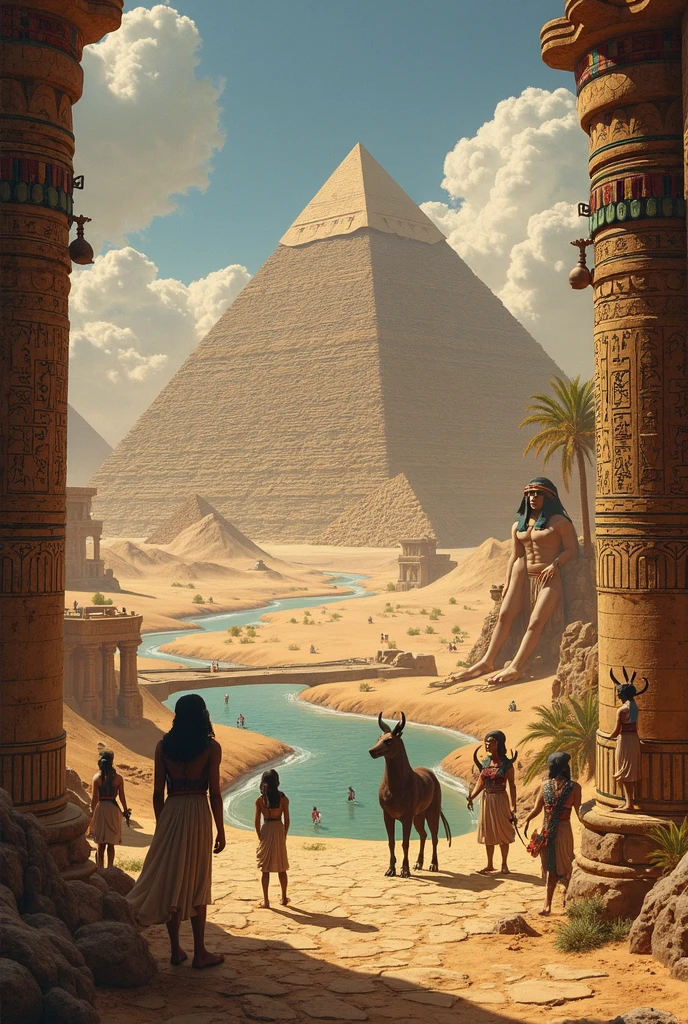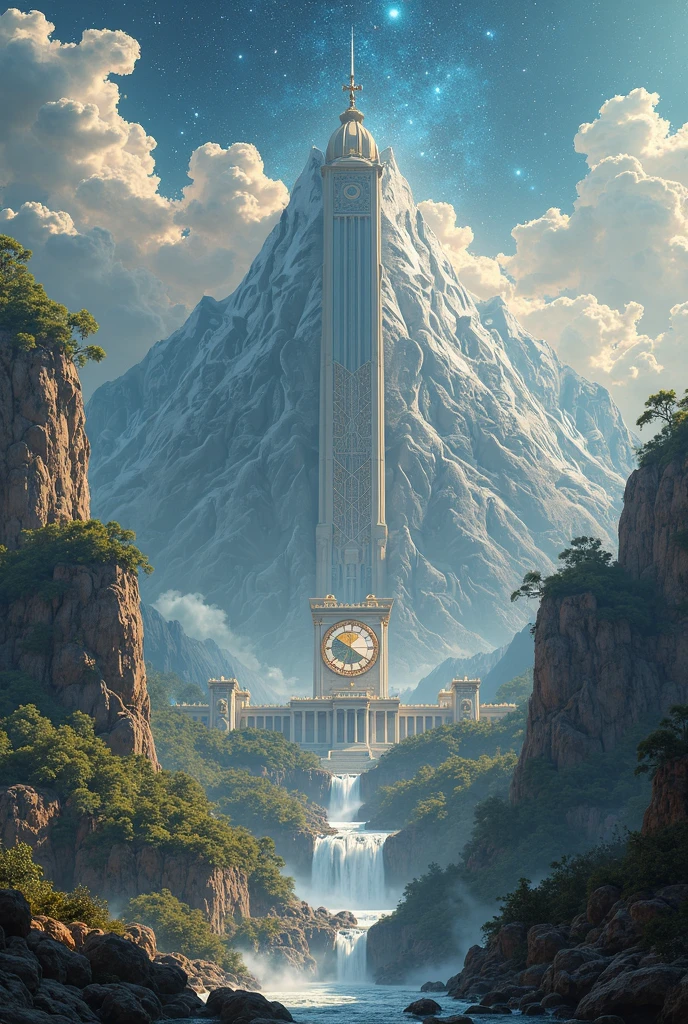Celtic Mythology: The Mystical World of the Tuatha Dé Danann
The rich tapestry of Celtic mythology is filled with enchanting tales of gods, goddesses, and legendary heroes. Among the most fascinating figures are the Tuatha Dé Danann, a divine race said to have ruled Ireland before the arrival of humans. Their stories, intertwined with powerful deities like Dagda, Morrigan, and Cernunnos, offer a glimpse into the spiritual beliefs of the ancient Celts.
Who Were the Tuatha Dé Danann?
The Tuatha Dé Danann, often translated as “People of the Goddess Danu,” were a supernatural race in Irish mythology. They were known for their mastery of magic, craftsmanship, and warfare. According to legend, they arrived in Ireland in a mist, bringing with them four sacred treasures:
- The Stone of Fal (Lia Fáil) – Screamed when the rightful king stood on it.
- The Spear of Lugh – Ensured victory in battle.
- The Sword of Nuada – Never missed its target.
- The Cauldron of Dagda – Provided endless nourishment.
Their reign ended after a great battle against the Milesians, forcing them to retreat into the Otherworld, often associated with Avalon or the fairy mounds of Ireland.
Key Deities of Celtic Mythology
The Tuatha Dé Danann included many powerful gods and goddesses, each embodying different aspects of life, nature, and war. Below are some of the most significant figures:
Dagda: The Good God
Dagda, often called “The Good God,” was a father figure and a protector of the tribe. He wielded a massive club that could kill with one end and revive with the other. His cauldron, one of the four treasures, symbolized abundance and hospitality.
Morrigan: The Phantom Queen
Morrigan, a goddess of war and fate, often appeared as a crow or raven on the battlefield. She was both feared and revered, as she could influence the outcome of battles and foretell doom.
Cernunnos: The Horned God
Cernunnos, depicted with antlers, was a god of nature, fertility, and the underworld. He symbolized the cycle of life, death, and rebirth, often associated with animals and the wilderness.
The Role of Druids in Celtic Mythology
The Druids were the spiritual leaders, scholars, and judges of Celtic society. They played a crucial role in preserving myths, conducting rituals, and interpreting omens. Their knowledge of nature, astronomy, and magic made them indispensable in Celtic culture.
| Celtic Deity | Domain | Symbol |
|---|---|---|
| Dagda | Protection, abundance | Club, cauldron |
| Morrigan | War, fate | Crow, raven |
| Cernunnos | Nature, fertility | Antlers, serpent |
The Legend of Avalon
While Avalon is more commonly linked to Arthurian legend, its roots may lie in Celtic mythology. Often described as an island of apples and eternal youth, it was believed to be a place of healing and magic, possibly connected to the Otherworld of the Tuatha Dé Danann.
Celtic Mythology in Modern Culture
The influence of Celtic mythology can still be seen today in literature, films, and neo-pagan traditions. The tales of the Tuatha Dé Danann and their gods continue to inspire fantasy writers and spiritual seekers alike.
For further reading, check out these resources: Ancient History Encyclopedia, Britannica, and IrishCentral.
Explore more fascinating articles on mythology and history, and don’t forget to follow us on facebook.com/zatiandrops for daily updates!
The Otherworld: A Realm Beyond Mortal Reach
The Otherworld was a central concept in Celtic mythology, often depicted as a parallel dimension where the Tuatha Dé Danann retreated after their defeat. Unlike the Christian afterlife, this realm was neither heaven nor hell but a place of eternal youth, feasting, and magic. Legends describe it as accessible through:
- Sídhe mounds (fairy hills) – Hidden gateways scattered across Ireland.
- Sacred lakes – Like Loch Gur, where the goddess Áine was said to reside.
- Certain festivals – Such as Samhain, when the veil between worlds thinned.
Tír na nÓg: The Land of Eternal Youth
One of the most famous Otherworldly realms was Tír na nÓg, ruled by the sea god Manannán mac Lir. In the tale of Oisín and Niamh, a mortal warrior was lured there, only to age centuries upon returning to Ireland. This story symbolized the Celts’ belief in cyclical time and the dangers of disrupting natural order.
Lesser-Known Celtic Deities and Their Roles
Beyond the major gods, Celtic mythology brimmed with lesser-known but equally fascinating figures:
Brigid: The Triple Goddess
Brigid, associated with fire, poetry, and smithcraft, was a triple deity embodying maiden, mother, and crone. Later Christianized as St. Brigid, her sacred flame at Kildare was tended by priestesses for centuries.
Lugh: The Master of All Arts
Lugh Lamhfada (Lugh of the Long Arm) was a polymath god skilled in warfare, craftsmanship, and magic. His festival, Lughnasadh (August 1st), celebrated harvest and athletic contests.
Aengus Óg: The God of Love
Son of Dagda, Aengus Óg ruled over love and dreams. His most famous myth involved stealing a swan-maiden, Caer Ibormeith, by recognizing her among 150 identical swans—a metaphor for soulmate recognition.
| Deity | Attribute | Modern Influence |
|---|---|---|
| Brigid | Fire, creativity | Inspires feminist spirituality |
| Lugh | Skill, leadership | Namesake of Lyon (Lugdunum) |
| Aengus Óg | Romance, youth | Featured in W.B. Yeats’ poetry |
Celtic Heroes and Their Supernatural Quests
Mortal heroes in Celtic myths often interacted with gods, undertaking perilous journeys that blurred the line between human and divine.
Cú Chulainn: The Hound of Ulster
The demigod Cú Chulainn, trained by the warrior-woman Scáthach, possessed a ríastrad (warp spasm) that transformed him into a monstrous force during battle. His tragic death, tied to geasa (taboos), underscored Celtic themes of fate and honor.
Fionn mac Cumhaill and the Salmon of Wisdom
Leader of the Fianna, Fionn gained omniscience by accidentally tasting the Salmon of Knowledge. His adventures, like outwitting the fire-breathing Aillén, showcased cleverness over brute strength.
Sacred Animals in Celtic Lore
Animals were revered as messengers or incarnations of deities:
- Ravens – Linked to Morrigan and prophecy.
- Boars – Symbols of fertility and courage (e.g., the magical boar Twrch Trwyth).
- Salmon – Embodied wisdom, as seen in the Boyne River legends.
Celtic Rituals and Seasonal Festivals
The Celtic year revolved around four fire festivals, each marking transitions in nature and myth:
- Imbolc (February 1) – Honored Brigid, celebrated lambing season.
- Beltane (May 1) – Welcomed summer with bonfires and fertility rites.
- Lughnasadh (August 1) – First harvest, games, and marriages.
- Samhain (October 31) – New Year, when spirits walked the earth.
The Role of Sacred Trees
Druids worshipped trees, especially the oak (Duir in Ogham script). The Crann Bethadh (Tree of Life) represented interconnectedness, while mistletoe, cut during rituals, was considered a panacea.
Archaeological Evidence of Celtic Beliefs
Artifacts like the Gundestrup Cauldron (Denmark) and Tara Brooch (Ireland) depict gods and symbols. Key sites include:
- Newgrange – A 5,000-year-old tomb aligned with the winter solstice.
- Uisneach – The mythical center of Ireland, where the Bealtaine fires were lit.
Celtic Mythology vs. Norse and Greco-Roman Traditions
Unlike the linear sagas of Norse myths or the structured pantheon of Greece, Celtic stories emphasized:
- Fluid identities – Gods shifted forms (e.g., Morrigan as a crow, hag, or maiden).
- Localized worship – Deities were tied to specific landscapes, like rivers or mountains.
- Oral tradition – Most myths were recorded by Christian monks, blending pagan and Christian elements.
For deeper dives, explore: Celtic Learning Resources, BBC History, and Mythical Ireland.
Explore more fascinating articles on mythology and history, and don’t forget to follow us on facebook.com/zatiandrops for daily updates!
The Concept of Geasa: Sacred Vows and Taboos
In Celtic mythology, geasa (singular: geis) were sacred prohibitions or obligations placed upon individuals, often heroes or kings. Breaking a geis usually led to dire consequences, serving as a narrative device to explain tragic downfalls. These taboos could be:
- Personal – For example, Cú Chulainn was forbidden to eat dog meat, yet was offered it, leading to his weakening before battle.
- Royal – Irish kings often had geasa tied to their sovereignty, like never refusing hospitality.
- Magical – Some were imposed by druids or gods as tests of character.
The Power of Oaths
Celts held oaths as unbreakable bonds. The legendary Children of Lir were cursed by their stepmother’s oath, transforming them into swans for 900 years. This emphasis on verbal contracts reflected the culture’s reliance on oral tradition.
Celtic Goddesses of Sovereignty
Female deities often symbolized the land itself, with kingship granted through symbolic marriage to the goddess. Notable figures include:
Ériu, Banba, and Fódla
These three sisters personified Ireland. Ériu’s name became Éire, the modern Irish word for the nation. Their blessings were sought by invading tribes to legitimize rule.
Macha
Macha of the Red Hair appeared in multiple forms: a warrior, a fertility figure, and as the doomed horse-racing goddess who cursed Ulster’s men with labor pains during conflict.
| Goddess | Role | Sacred Site |
|---|---|---|
| Ériu | Land embodiment | Hill of Uisneach |
| Macha | Sovereignty & war | Emain Macha (Navan Fort) |
The Celtic Underworld: Not Just a Dark Realm
Contrary to later Christian interpretations, the Celtic underworld (Annwn in Welsh lore) was a place of rest and renewal. Key features included:
- Cauldrons of rebirth – Like Dagda’s vessel or the Pair Dadeni in Welsh myth, which revived dead warriors.
- Silver branches – Carried by Otherworld messengers to invite mortals to the gods’ realm.
- Time distortion – A night in the Otherworld could equal centuries in the mortal realm.
Celtic Creation Myths
Unlike other European traditions, Celtic cosmology often began with primordial giants or the interplay of elemental forces:
The Battle of Mag Tuired
This epic conflict between the Tuatha Dé Danann and the monstrous Fomorians represented order overcoming chaos. The god Lugh slew the one-eyed Balor, echoing later cyclops myths.
Welsh Beginnings
The Mabinogion describes creation arising from the union of the primal goddess Dôn and the underworld lord Math, shaping the landscape through divine struggle.
Celtic Symbols and Their Meanings
Artifacts and manuscripts reveal recurring motifs:
- Triskelion – A triple spiral representing motion and cycles.
- Shamrock – Later Christianized but originally tied to triple goddesses.
- Hound motifs – Symbolizing loyalty and protection (e.g., Cú Chulainn’s namesake).
The Influence of Celtic Mythology on European Folklore
Many pan-European tales have Celtic roots:
- Arthurian legends – Merlin shares traits with wild druids like Myrddin Wyllt.
- Fairy lore – The Aos Sí (Tuatha Dé Danann descendants) became the “Good Folk” of later superstitions.
- Werewolf myths – Celtic warriors like Laignech Fáelad wore wolf pelts in battle.
Banshees and Other Death Omens
The bean sídhe (“woman of the mounds”) evolved from territorial goddesses like Badb into the wailing ghost of later folklore, showing how pagan beliefs persisted under new guises.
Modern Revival and Misconceptions
Contemporary neo-pagan movements sometimes oversimplify Celtic traditions. Historical accuracy requires noting:
- No unified pantheon – Deities varied regionally (Gaulish Taranis vs. Irish Dagda).
- Limited primary sources – Most texts were recorded centuries after Christianization.
- Seasonal rites – Modern “Celtic Wicca” often blends 20th-century ideas with ancient fragments.
For scholarly perspectives, consult: Oxford Reference, Order of Bards, Ovates & Druids, and Celtic Jewelry.
Explore more fascinating articles on mythology and history, and don’t forget to follow us on facebook.com/zatiandrops for daily updates!
The Celtic Concept of Reincarnation and the Soul
Unlike many ancient religions, Celtic mythology contained strong beliefs about reincarnation and the transmigration of souls. The druids taught that death was merely a transition to another form of existence. This belief manifested in several ways:
- Heroic rebirths – Many legendary figures were said to be reincarnations of earlier heroes or gods.
- Shape-shifting – Deities like Morrigan could transform into animals, suggesting fluid soul movement.
- Otherworld journeys – Tales like “The Voyage of Bran” describe souls traveling between worlds.
The Cauldron of Rebirth
Several Celtic myths feature magical cauldrons that could restore the dead to life, though sometimes with important changes. The most famous was the Cauldron of Dagda, which not only provided endless food but may have symbolized cyclical rebirth.
Celtic Tree Lore and Ogham Alphabet
The ancient Celts developed a sophisticated system of tree symbolism and a unique writing system called Ogham:
| Ogham Letter | Tree | Symbolic Meaning |
|---|---|---|
| Beith (B) | Birch | New beginnings, purification |
| Duir (D) | Oak | Strength, doorway to wisdom |
| Saille (S) | Willow | Intuition, moon magic |
This arboreal alphabet was used for inscriptions and divination, with each letter/few representing a different tree and its associated magical properties.
Celtic Water Deities and Sacred Wells
Bodies of water held special significance in Celtic spirituality, often associated with specific deities:
Boann – Goddess of the Boyne River
The story of Boann explains the creation of the River Boyne in Ireland. She challenged the power of the sacred Well of Segais, causing its waters to burst forth and form the river.
Sulis – The Thermal Spring Goddess
At Bath in England, the Celts worshipped Sulis, a goddess of healing waters later syncretized with Roman Minerva. Her temple complex demonstrates how Celtic and Roman religious practices blended.
The Concept of “Thin Places” in Celtic Spirituality
The Celts believed certain locations served as portals between worlds. These thin places included:
- Hilltops – Like Tara and Uisneach in Ireland
- Shorelines – Where land meets sea
- Forest clearings – Especially those with ancient trees
- Standing stones – Such as those at Carnac in Brittany
These sites were considered especially powerful for rituals and communication with the Otherworld.
Celtic Lunar and Solar Calendars
The druids maintained sophisticated timekeeping systems that combined lunar and solar cycles:
The Coligny Calendar
Discovered in France, this bronze calendar from the 2nd century CE shows a complex lunisolar system with:
- 12 lunar months plus intercalary months
- Markings for auspicious and inauspicious days
- Integration with seasonal festivals
The Celtic Year
The Celtic year was divided into a light half (Beltane to Samhain) and dark half (Samhain to Beltane), reflecting their dualistic worldview of complementary opposites.
Celtic Musical Traditions and Mythic Instruments
Music played a vital role in Celtic rituals and mythology, with several legendary instruments:
The Dagda’s Harp
Dagda possessed a magical harp called Uaithne that could control seasons and emotions. When stolen by the Fomorians, it flew back to him at his call.
Chanting and Oracular Speech
Druids used specific poetic meters called roscanna for spells and prophecies. The power of spoken words was considered magical in itself.
Celtic Warrior Culture and Mythic Battles
Warfare in Celtic mythology followed specific spiritual protocols:
Single Combat Traditions
Heroes often fought one-on-one battles at river fords, following strict codes of honor. Cú Chulainn‘s combat with Ferdiad exemplifies this tradition.
War Goddesses and Battle Magic
Female deities like Morrigan, Badb, and Macha appeared on battlefields, influencing outcomes through supernatural means rather than physical fighting.
For more on these topics, explore: Celtic Wedding Rings, Library Ireland, and Celtic Earth Spirit.
Explore more fascinating articles on mythology and history, and don’t forget to follow us on facebook.com/zatiandrops for daily updates!


